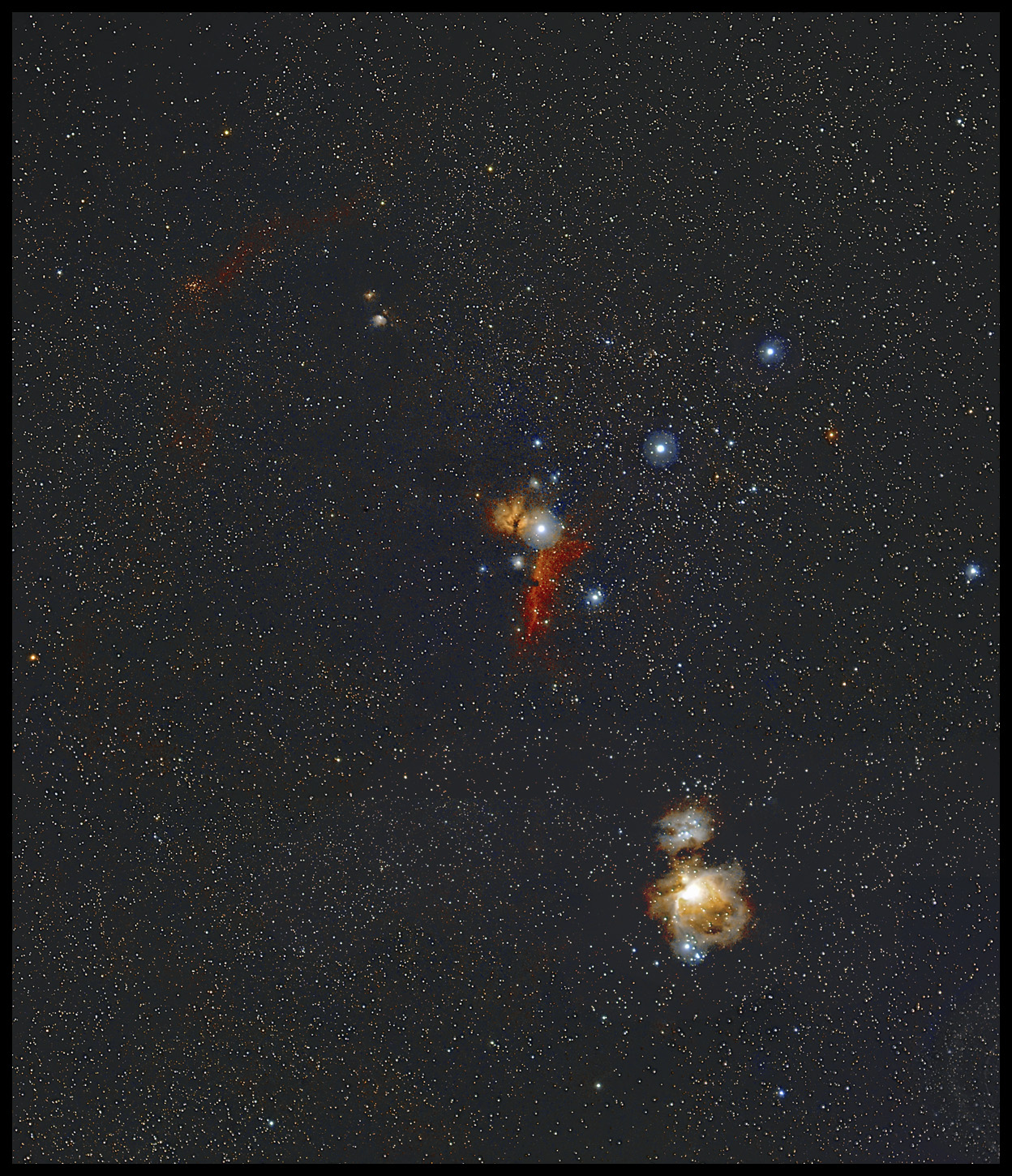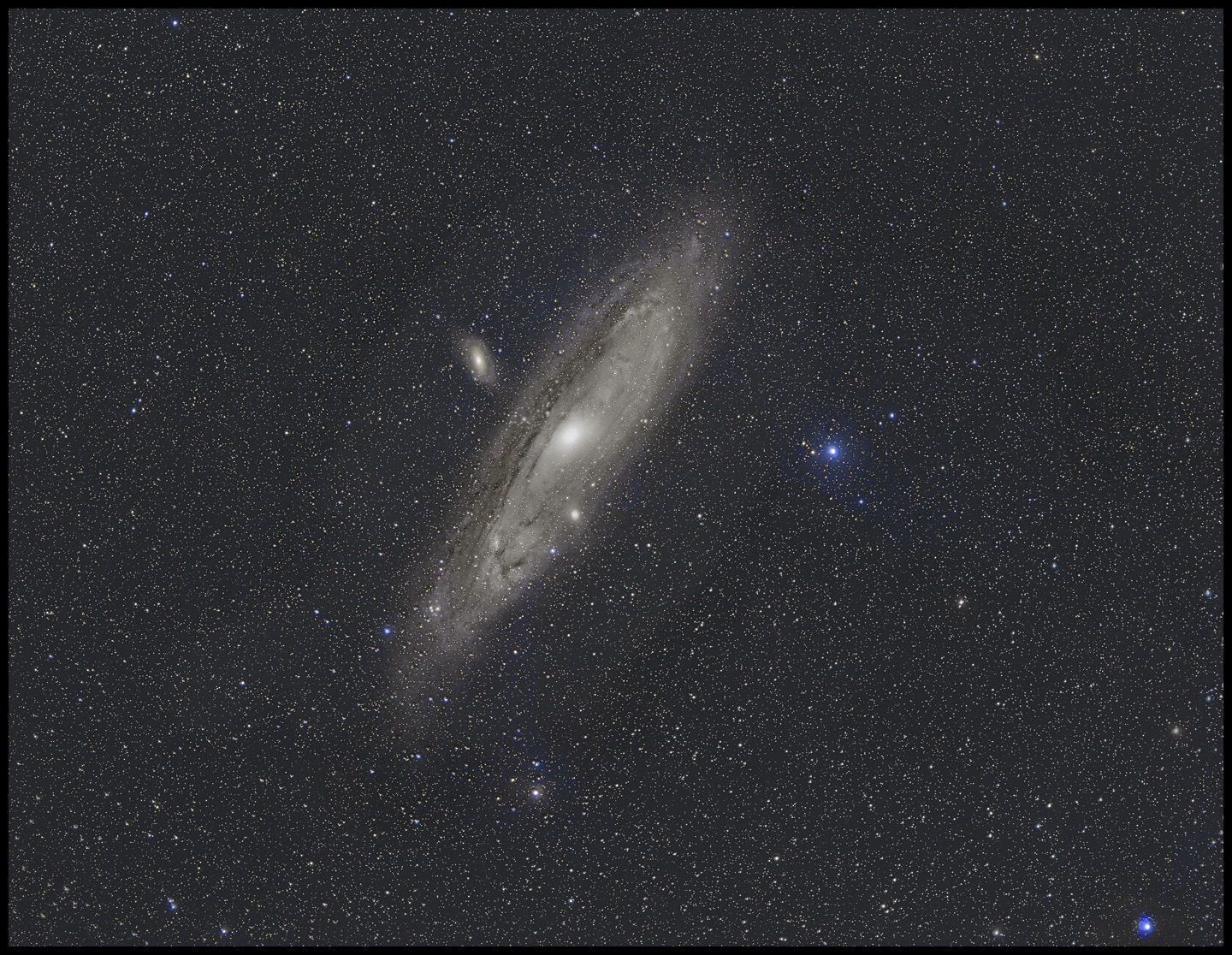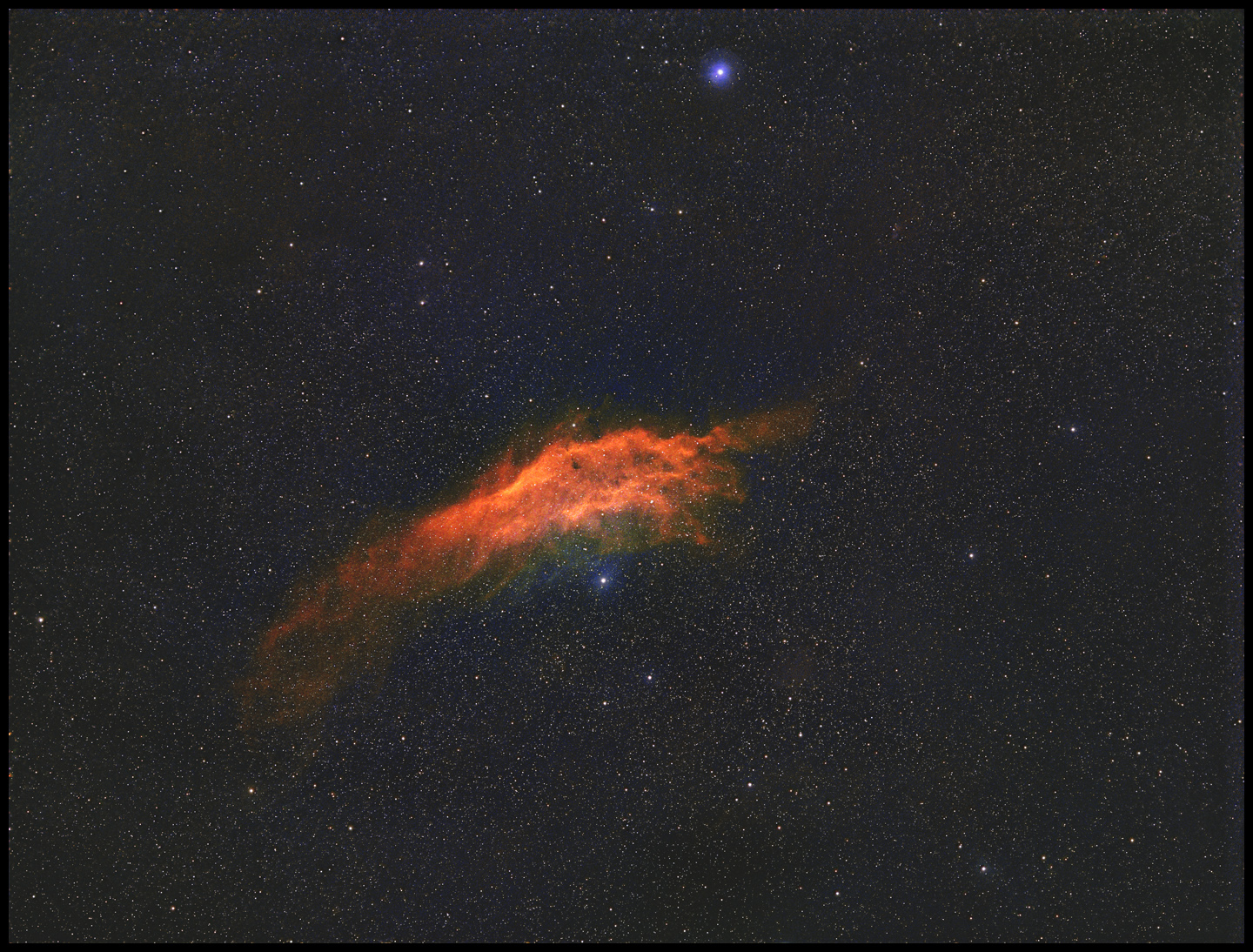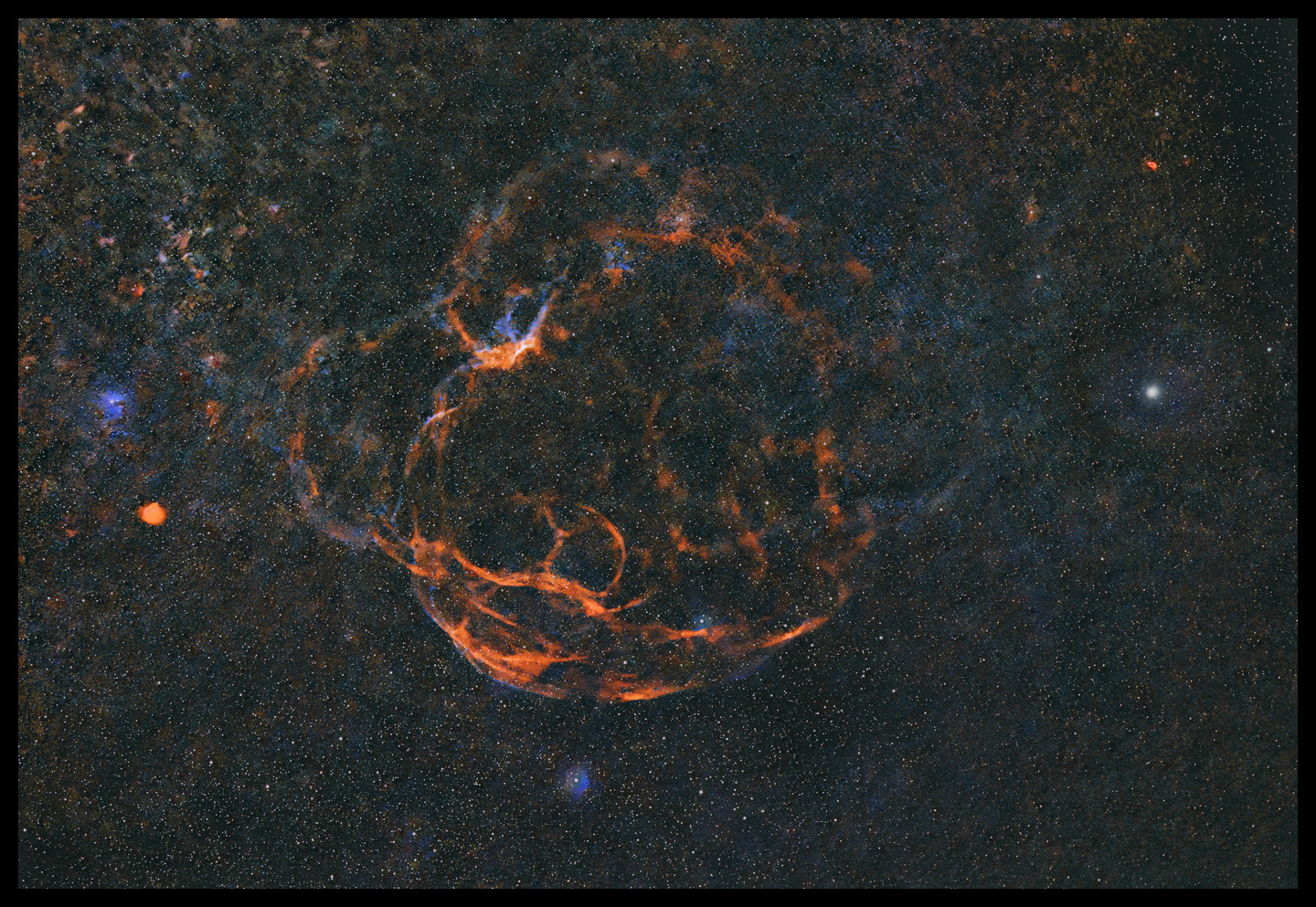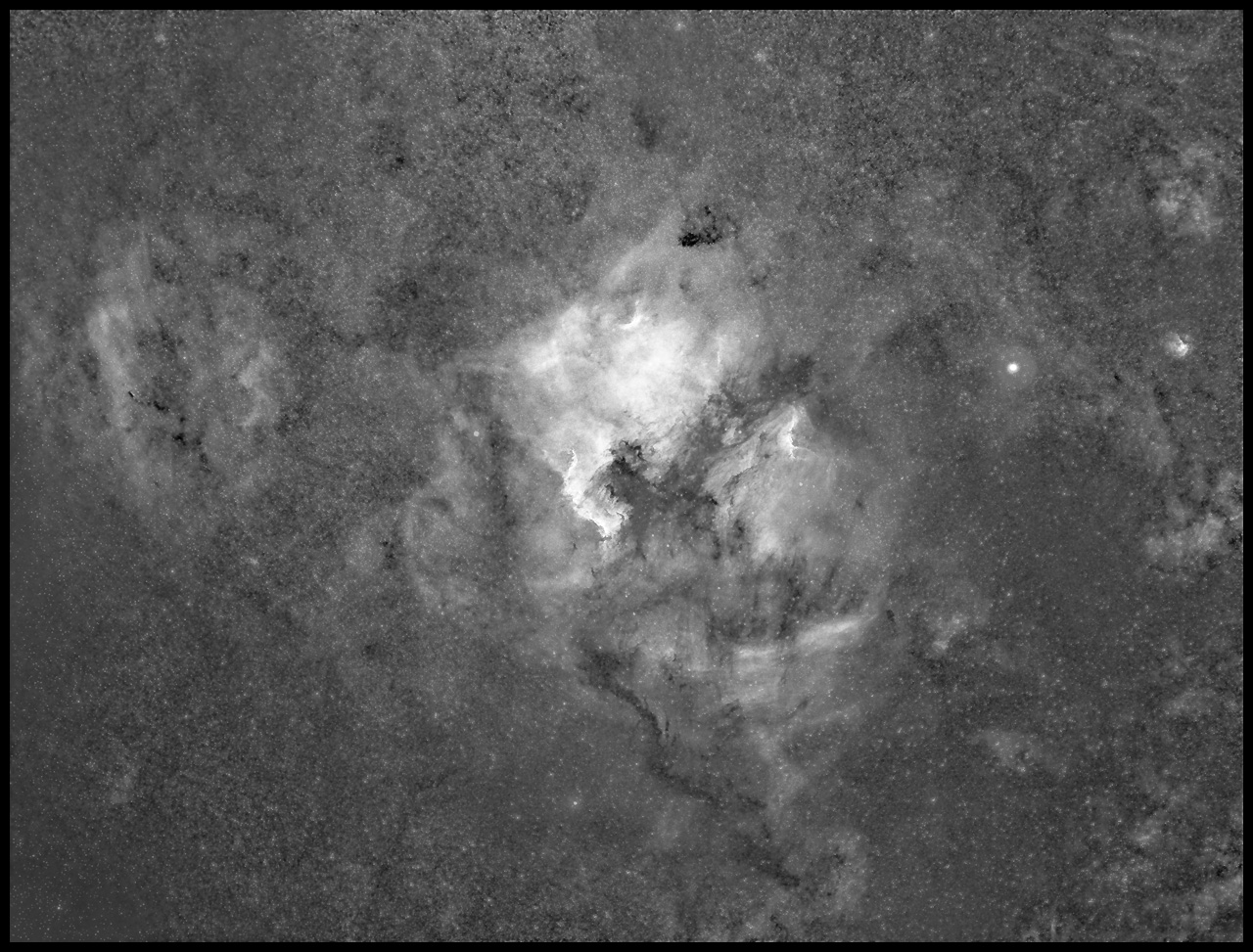The Starry Night, 266 :: home :: |
OSC, part two
The main event for tonight is a series of photos of central Orion, everyone's fave. In Guide, I worked out a composition with the belt, M78, and Barnard's Loop. It should be a good standalone field and a good upper half for a wider panorama. About an hour before midnight, I did some casual 10-second UV/IR cut images (two panels, north and south, five minutes total for each). Clickable, of course:
Then I swapped the UV/IR filter for the Svbony 220 Dual Band. It is anything but parfocal with the UV/IR, and I need a better focusing routine than simply nudging the focus ring and declaring "good enough" when the images are tolerably sharp or my patience is gone. The camera shifted while I changed filters, and I spent some time recomposing. The dual band filter requires much longer exposures. Where composition is easy with the UV/IR filter using 2-second exposures in Bin2, 10 is not really long enough with the Duoband. Stars are simply not prominent. I went to 30s to find my way back and was puzzled by a red "glare" running across the frame; a light leak? I thought. It took a while to realize that it was Barnard's Loop. You know that finder 'scope I mentioned earlier? That would be good. (For the 105 at least, maybe try the red dot finder on a suitable adapter.) I started a series of 60-second frames; I'd like a couple of hours worth. I worried that dew or frost might cover the lens since I did not plug up a dew strap tonight. I'm not sure the small battery I'm using will drive the ASI1600MC with modest cooling, the mount, and a dew strap. We'll see how it does with the first two. And I am pretty confident that even if dew cuts the sequence short, the first ten or twenty will provide enough signal to be rewarding. F1.4 is like that. As it happens, no frost tonight:
Notes: The dual band filter: I selected the Svbony 220 filter from its competitors for its relatively wide bandpass. Ordinarily, the narrower the better, but I specifically wanted this filter's 7nm windows because I wanted to use it with very fast glass. I thought the wider bands would allow better, flatter H-a and O-iii performance across the field. So far so good. Real estate: you don't need to use that inconvenient south slope at the community lot except when reaching for far southern targets; setting up in the gravel will provide access to a lot of sky. Take a table! There's traveling light and there's traveling too light. Juggling the camera, its lens adapter, filter rings, and filters in the dark by the light of a dimmed computer screen propped up on frozen ground is too much. Maybe by March, I will not think 21F is pretty damned cold, but tonight I am wearing full cold-weather regalia, and my fingers ask me if I am serious when I direct them to do most anything. I went home to wait out the two hour sequence, I fixed hot chocolate. When the packet of chocolate hit the hot water, the smell proved to be a madeleine: bang, back on the Middle Fork at the kitchen table with George on a warmup break while learning my way around the deep sky. Coal-smoke, dogs barking in the far distance, and roosters in the dawn -- none were mentioned in the list of ingredients but all were included just the same. Techbits: For dual band images, I'm running gain 300, -15C tonight. The 60s subs have been calibrated with dark frames only; the 10s subs are au naturel. I centered Polaris in the guide reticle; nothing subtle there. Close examination of the dual band photo of Orion just above will show that it includes substantially more sky than the lens "should" encompass. That's because there was a slow drift in dec owing to imperfect polar alignment. It was a happy accident. I aligned the 115 frames once on the first frame and again on the last frame and merged the two stacks. In the end, I only used the 60s frames; the highlights were easily recoverable without resorting to shorter exposures.
2024/12/05. Who needs darks? I screwed up and shot more darks at Gain 300 rather than a set at 139, so tonight's Messier 31 will have to appear uncalibrated. It does not appear that the lack caused much or maybe any damage to the final image:
Lookitthat! M32 wholly embedded in the spiral arms of M31; NGC 206 nowhere near the outermost stars; the twisted tips of the warped outermost disk. This is fun!
2024/12/06. I used a gender-changing adapter (illegal in Tennessee) to mount the tiny red-dot finder (Stellarvue F2) that came with the new-to-me TMB92SS 8 years ago. The finder is still running on the original battery, I think. It's riding on the ASI1600MC's Arca-Swift foot. I intended to shoot the complex nebulosity around M52, but when I used Deneb to check the alignment of the finder, I saw that NGC 7000 was still high in the western sky. So I opted instead for a reminder of summer's skies on this crisp winter evening. Earlier today, I took 100 dark frames at the appropriate binning and gain, so this time we'll try a bit of calibration:
I've ordered a metal lens hood for the 105. It's a little longer than the official hood. That should present no problem with the smaller sensor in the ASI1600 cameras. The extra length should be good for dew prevention, and, more to the point, unlike the official lens hood, this one is heat conductive so dew prevention straps should work well. (I haven't had any trouble with dew or frost in quite a while, but that huge front element seems to be just asking for it.) I ended the North America Nebula photos after 76 frames of my planned 120. The field was approaching the pines, and it was time to watch "A Christmas Story" with Amy. With Ralphie's blue steel beauty once again secured, I went outside to line up a new subject. NGC 1499, the California Nebula. I figured it's big, bright, easy to find, and ought to look good with the dual band filter. Have a look:
The red dot finder worked perfectly. It got me into the neighborhood nicely (dial it in for use with the 400mm). The nebula was just emerging from meridian pine, but the camera turned it up easily through the boughs(!). I centered the glow, checked focus, and launched a long series of 60 second exposures before retreating inside. I took 240 frames, 4 hours worth, but discarded the first 20 since they included the tree-top silhouetted against the sky. That would mess up eventual histogram work. The temperature out there is 24oF (-4C), and the cooler is working at just 9% to bring the chip to -15C, a delta of 11 Celsius degrees. Keep in mind that -15C is 4oF so it's just possible that the local air will sometimes be cold enough to require exposing at -20C or below to maintain a controlled sensor temperature. That will require cold-weather darks. The Li-ion battery that drives the kit lasts approximately forever under these conditions. (But get a bigger one anyway so the A-P and a dew heater can keep up the good work in warmer weather.)
2024/12/07. Now let's try something fainter. Simies 147, aka Sharpless 240, is a supernova remnant just east of El Nath, the southernmost bright star of Auriga. It wasn't discovered until 1952 at the Crimean Astrophysical Observatory using captured German optics. So, in honor of Pearl Harbor Day:
Click it to see much of anything. Glare from all this white border hides the good stuff. This 2h18m exposure is a decent beginning, but only just. I've done pretty much everything I know to do to bring this much up. (Overview of the workflow: calibrate with dark frames; debayer; align; average w/Windsorized sigma rejection; deconvolve; stretch; remove stars; faux flat; stretch some more; adjust saturation; layer stars back in; season as needed for display.)
2024/12/10. Yes! You can effetively extract the red channel for pure H-a imagery using the dual band filter, so moonlight shouldn't be a showstopper.
'Course, only one in four pixels in the 1600MC is recording a useful signal in the narrow H-a regime. Efficiency probably sucks compared to the 1600MM, but still... The O-iii signal isn't totally useless even under poor sky conditions, especially when processed separately. Play with it under both good and challenging skies. Putting it to work will probably require mixing the B and G channels.
:: top :: |
© 2024, David Cortner
